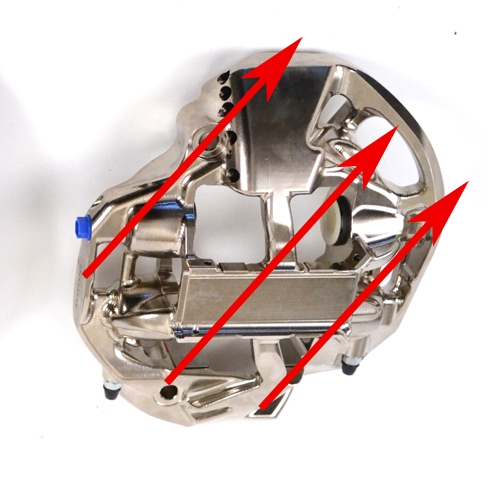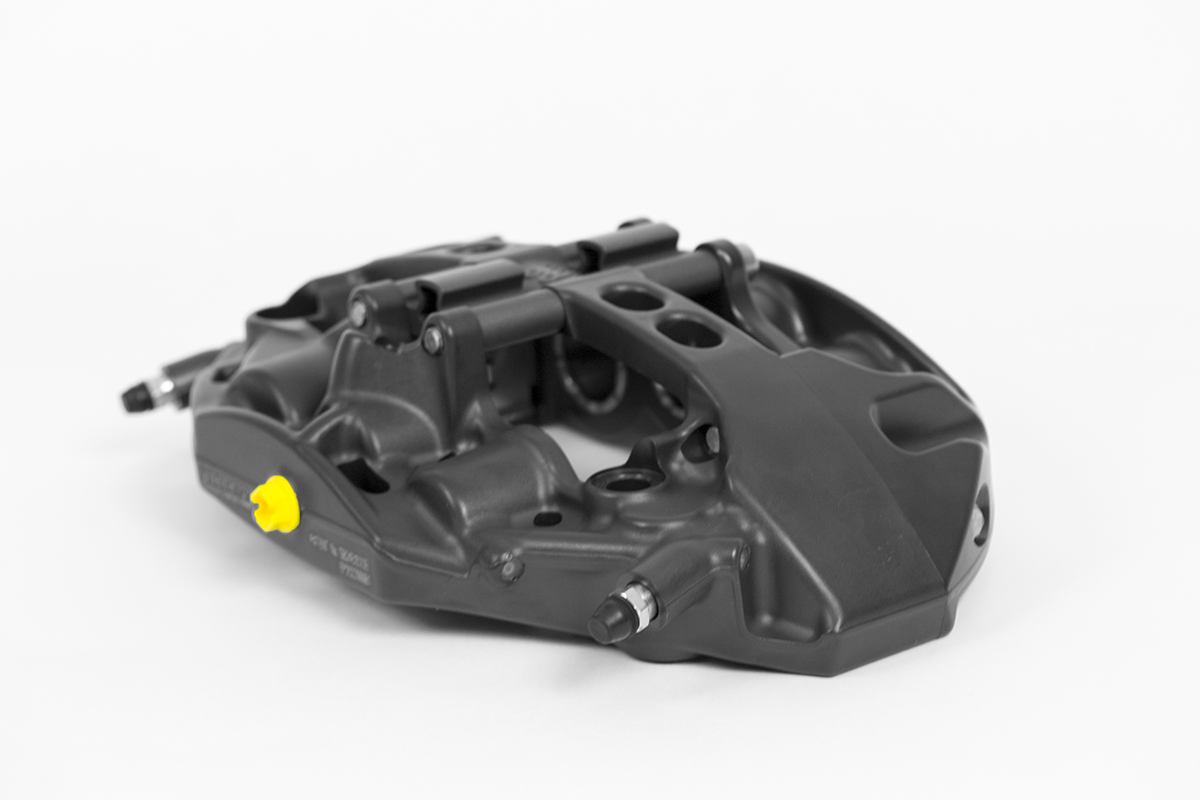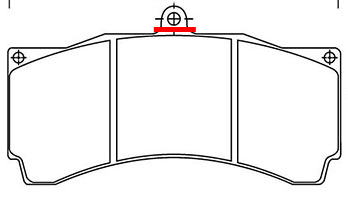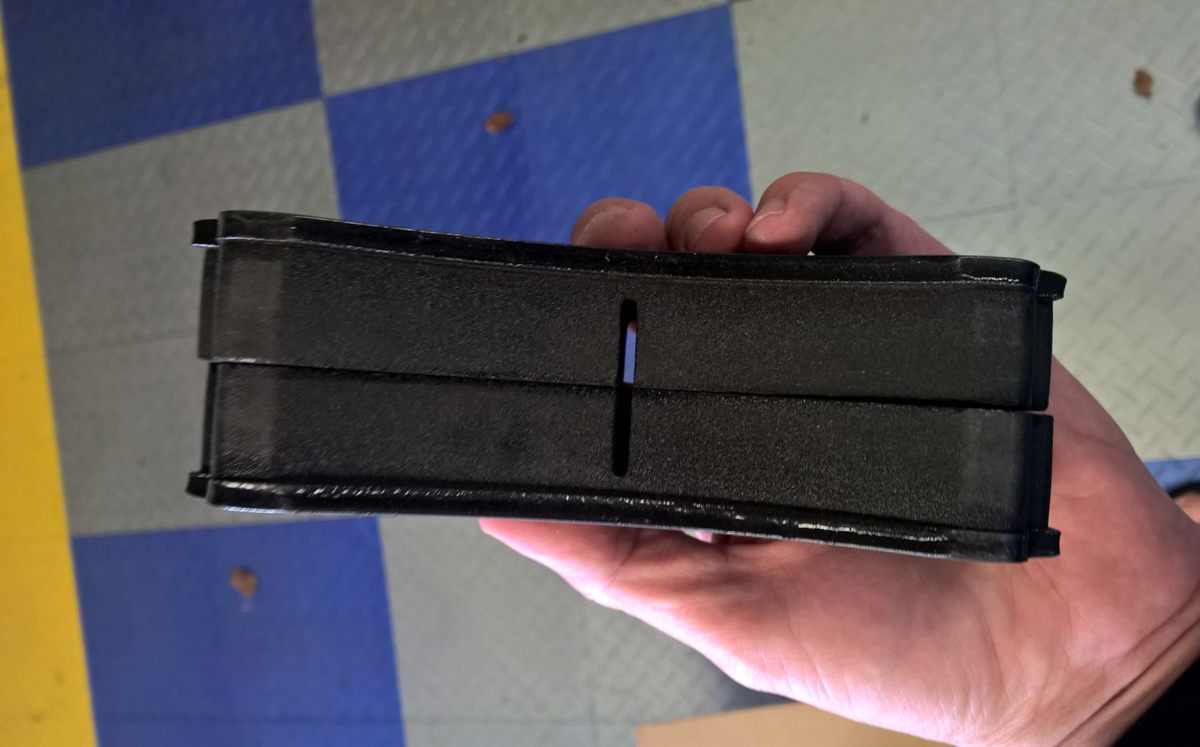



















AP Racing by Essex Radi-CAL Competition Brake Kit (Front 9668/372mm)- F87 M2 & M2 Competition, F80 M3, F82 M4
- $5,699.00 USD
$5,699.00 USD- $5,699.00 USD
- Unit price
- per
-
WHAT'S IN THE BOX?

- One pair AP Racing CP9668 Radi-CAL Pro5000R six piston calipers
- One pair 372x34mm AP Racing CP7177, 72 vane, J Hook racing discs, with fully floating 6061 hard anodized aluminum hats, and attachment hardware
- One pair caliper mounting brackets and hardware
- One pair Spiegler Stainless Steel Brake Lines with abrasion resistant coating
- Detailed installation instructions
- Brake pads are NOT included with our system. Racing brake pads are a highly personal choice. Many manufacturers include a set of inexpensive, low quality pads with their brake kits. Rather than artificially inflating the price of our system with a set of pads you probably don't want anyway, we've decided to remove the cost from our system and allow our customers to choose the pads that best suit their needs/wants. When purchasing our kit, you are able to choose one set of front pads at a substantial discount vs. the retail price. Please use the drop-down menu to select your pads.
- Pad Tension Clips (frequently referred to as anti-rattle clips) are NOT included with our Competition Kits, but we do offer them as an option if you're concerned about NVH. One of the great benefits of the AP Racing calipers in our system is that they are designed to accommodate pads from a wide range of manufacturers. Each manufacturer builds their pads with specifications that are slightly different. As such, pads from different manufacturers, or even from different batches, won't always fit in the calipers in exactly the same manner. Some pads are a snug fit, while others may rattle around and produce noise. The Essex Designed Pad Tension Kit is designed to dramatically reduce pad movement inside the caliper, along with just about all resulting noise. Click here to add the pad tension kits for the CP9668 calipers in this brake kit to your shopping cart. Please note that each caliper requires one Pad Tension Kit. If you need enough tension blocks for both of your calipers, you need to order two of these kits!
RADI-CAL
“Radi-CAL” is a blanket term used to describe AP Racing’s patented asymmetrical brake caliper design. Radi-Cal technology is grounded in Computer Aided Design (CAD) and Finite Element Analysis (FEA), and allows for organic, alien-looking designs that are a radical departure from conventional caliper designs of the past. Radi-CAL's are widely considered the pinnacle of current brake caliper technology. Since their inception in 2007, these revolutionary calipers have amassed a lengthy string of race victories at all levels of professional motorsport, while redefining brake performance expectations. For more details on the design concept and what these calipers have achieved in professional racing, please visit our blog and read The AP Racing Radi-CAL Story.
The key benefits of the Radi-CAL design:
- Massive Stiffness Increase- A 30+ % increase in both static and dynamic stiffness vs. conventional calipers allows for far less deflection under load, which means superior pedal feel & modulation, more even pad wear, and longer caliper service life.
- Considerable Mass Reduction- Removing all extraneous caliper mass lowers the caliper weight, despite the huge stiffness increases.
- Optimized Airflow- Air moves around and through the caliper more efficiently, providing superior heat evacuation and cooling.
- Efficient Packaging- The asymmetric caliper profile and internal fluid porting allows the caliper to fit into tighter spaces.
CALIPERS
CP9668 PRO5000R, THE EVERYMAN RADI-CAL

It has taken eight years, numerous generations of the design concept, and advancements in manufacturing techniques, but the Radi-CAL has finally evolved into a viable solution for racers and enthusiasts of all levels and budgets. While many products are supposedly born in racing, there can be no doubt about the Pro5000R pedigree. These calipers are direct descendants of the current crop of F1 and Sprint Cup calipers. They don't look ordinary, because they're not ordinary. They're the epitome of pure racing design: elegant, sparse, and brutally effective. And while they embody and employ the Radi-CAL design philosophy of the past, they also add some outstanding new features that enhance their practicality, convenience, and appeal. Quite simply, they are the lightest, stiffest, and most technologically advanced brake calipers that have ever been within the average enthusiast's grasp.
These intricate calipers have traditionally been machined from proprietary aluminum alloy billets. As one can imagine, machining away all of that material to achieve the final form is both time-consuming and costly. As a result, the price of these calipers has historically been prohibitive for the average club racer, time-trialer, or HPDE participant. Fortunately, the Pro5000R calipers use a new drop-forging technique that has dramatically lowered the manufacturing cost and the resulting price of entry, bringing this incredible technology to the masses.
Radi-CAL = Massive Dynamic Stiffness Increase
Over the years, many different strategies have been employed to shrink the brake caliper footprint while maintaining adequate stiffness: More robust caliper bridge designs, two-piece calipers with steel through-bolts, exotic materials (i.e. Beryllium, MMC), forging rather than casting, monobloc design, etc. All of these innovations pushed calipers towards becoming lighter, smaller, and stiffer. However, until the advent of the Radi-CAL, the same basic rectangular, boxy shape remained the accepted standard.
Is a rectangular box really the most appropriate and efficient shape for a brake caliper? AP Racing has now proven that it is not. As a brake caliper clamps brake pads against a spinning disc, a tremendous tangential friction force occurs between the pads and the spinning disc. In other words, the caliper is pulled strongly in the direction of the spinning disc, as represented by the downward pointing arrow on the right side in Figure 1 below. The caliper resists that force via the spindle hard mounting points, depicted by the upward arrow on the left. The dynamic load placed on the caliper twists or pulls the caliper into a parallelogram shape.
Figure 1


The dynamic force exerted on the calipers during a braking event is the key to the magic of the Radi-CAL design philosophy. Brake calipers of the past were designed to some extent in relative isolation from the forces that they were attempting to combat. They were designed to be the stiffest box possible while resting on a table, with much of the caliper mass residing at either end. The Radi-CAL is dramatically different because it was deliberately designed around the braking event forces that will be acting upon it. This is achieved by optimally distributing the body mass of the caliper on a diagonal, rather than at the two caliper ends. As such, the forces dynamically acting on the caliper are supported by the caliper mass, rather than what historically has been an empty box (see Figure 2 below). At the same time, this also allows for a significant reduction in overall mass, because all non-essential, non-load-bearing caliper body material is removed. So in the case of the Radi-CAL, it's not just about the material that is put into the caliper, it's about the material that is taken away!
Figure 2


WHAT DOES THE ABOVE MEAN FOR YOU, THE DRIVER? IT MEANS A SIGNIFICANTLY FIRMER BRAKE PEDAL WITH SUPERIOR MODULATION UNDER ALL CONDITIONS. IT ALSO MEANS MORE EVEN PAD WEAR WITH LESS TAPERING, AND A LONGER CALIPER SERVICE LIFE.
Radi-CAL= Ultra-lightweight, Compact Design with High Airflow
As mentioned above, the Radi-CAL design philosophy is just as much about what isn't there, as it is about what is there. The Radi-CAL design relocates caliper mass, creating voids that would traditionally not be located where they are. As such, considerable mass is removed from the body, and the entire envelope of the caliper is optimized. The result is an extraordinarily lightweight and compact footprint. Whereas many competing six piston calipers weigh in the 9-12 lb. range, the CP9668 weighs an astounding 6.8 lbs.!
The Essex mantra when designing brake kits has always been, "Anything larger than necessary to get the job done is simply dead weight to drag around," and the Radi-CAL aligns perfectly with those values. One of the major problems with many of the brake packages currently on the market is wheel fitment. You’re offered gigantic discs and 12 piston calipers, with a pat on the back and a, “Good luck finding wheels to clear those things (insert sinister chuckle here).” The reality is that many casual racers want to use their OEM wheels on the track, or the smallest, lightest wheel they can find. Not only is saving unsprung weight critical, R compound tires are much more plentiful and cheaper for smaller wheels. If the components are designed properly with heavy use in mind, you don’t need to cram boat anchors under your wheels. If you’re worried about the loss of stiffness due to mass reduction, don’t. Some manufacturers use a heavier six piston caliper, but that's because the caliper wasn't designed or optimized for racing. In those cases, the same caliper may have been designed for use on much heavier road cars, and even trucks! AP Racing’s Pro5000R calipers are incredibly stiff, and designed from scratch with only the racetrack in mind.
Take a look at the caliper above or below. Anything else missing? Outer bleed screws and crossover tubes! The Pro5000R range has internal fluid porting and only two bleed screws located on the inner caliper half. That means that the chance of knocking a bleed screw or denting a crossover pipe during a wheel change virtually disappears. It also means that you now have half as many bleed screws to turn when changing your brake fluid. Eliminating the piping and bleed screws also allows the outer corners to be rounded, improving wheel spoke clearance.
Finally, take a look at the picture below. Compared to a traditional caliper, the pistons and brake fluid pathways have far more airflow between and around them, lowering the overall system operating temperature.

Two-piece, Drop-Forged Caliper Body
Radi-CAL's such as the one in Figure 2 above have traditionally been machined from a single, solid block of proprietary aluminum alloy (monobloc). With a monobloc design, the piston bores and piston seal grooves can only be machined with a right angle machine tool (the tool must be inserted up and into the caliper). As one can imagine, machining away all of that material with special tools and multiple setups to achieve the final form is both time-consuming and costly. As a result, the price of monobloc Radi-CAL's has historically been prohibitive for the average club racer, time-trialer, or HPDE participant. The Pro5000R has been made possible by a newly developed 2-piece drop-forging process, which allows a conventional machine tool to access the piston bores via a direct path. The result is a drastic reduction in both production time and cost, while still retaining an incredibly stiff form.

Hard Anodized Finish
The first obvious weakness when looking at a typical aftermarket caliper is the finish. Most aftermarket calipers come in a painted finish, whether they are red, black, or gold. That painted finish is designed to look pretty and prevent corrosion in harsh winter environment. Unfortunately, for all of the compliments painted calipers generate, there is an associated price if you drive the car in a track environment. That price is the chipping, flaking, fading, color shift, and general degradation of that finish in a fairly short period of time. Some OEM calipers can go from the as-delivered color to a nasty shade of brown in as little as one weekend. While this is typically worn as a badge of honor among our more hardcore customers, let’s face it…they still look terrible. More importantly however, all of those bits of paint end up in places they’re not supposed to, which we’ll get to in a minute.
Why does this happen? Heat. Paint and powder coat cannot adequately handle track temperatures. Powder coat also has some notorious issues with shrinkage. The powder coat layer expands and grows when the caliper is heated. When it cools, the powder coat doesn’t necessarily shrink in step with the caliper body itself. What’s left is a loose shell of finish hanging limply on the caliper body. That shell then cracks and falls to pieces.
Paint can also have similar issues depending on how it is applied. If you were to line up a few aftermarket calipers from the same manufacturer, you would likely see that the painted finish on each of those calipers is slightly different. Some have a thicker coat, some thinner, slightly different shades of red, etc. Painting is to some extent an art form, and must be performed in a tightly controlled environment. If it isn’t, you’re always going to see variation. A thick coat makes the part look soft around the edges, and is prone to cracking off in the same manner as the powder coat described above, leaving the underlying finish exposed. A part without enough paint will look uneven, and will not protect the underlying aluminum particularly well either. In addition to problems with cracking, flaking, and uneven application, paint and powder coat also experience extreme color shift when heated. Red becomes maroon or black, gold becomes brown, and black just gets uglier.
The calipers we are using in the Essex Radi-CAL Competition Kits are ultra-lightweight, stiff, and durable under all track conditions. The finish is a hard anodizing, which is the business under track conditions. When raw aluminum reacts with the oxygen in the air, a hard surface film develops on aluminum which prevents further degradation. The process is called oxidation, and you can think of it like rust. The anodizing process leverages this natural phenomenon, and takes it a step further to produce an extremely hard protective layer of aluminum oxide. It does so by running an electrical current through an acid bath, and dying it to the desired color. If you want to know more, Google it.
The result is a finish that is far more appropriate for racetrack use. Anodizing creates a uniform surface that is much more abrasion resistant than paint or powder coat. That means if you ding an anodized caliper with a box wrench when bleeding it, a big chunk of the finish isn’t going to chip off into your hand. While anodized calipers will still exhibit color shift, it will take a lot more heat to get them to change, and they won’t change as dramatically. More importantly though, you aren’t going to have bits of anodizing sticking to the sides of your pistons.

Brake Pads in A Commonly Available Shape
Yes, those are the pads this caliper uses! If you're looking for maximum longevity from your pads, this is your solution. The basic pad shapes for the Pro5000R calipers were created by AP Racing many years ago, and are used by a wide range of racing calipers today. They're available in just about every popular racing compound on the market. That means you’ll never end up in a pinch without pads.
Below is a drawing of the basic pad shape:

Dimensions= 152.1 x 54 x 25 mm
Pad Retention Loop
The basic pad shape above comes from some manufacturers with a small loop on the top edge (the portion above the red line in the drawing above). On certain calipers a pad retention pin is placed through that loop to hold the pads in place. That small loop is not used in the AP Racing Pro5000R Radi-CAL's however, and must be removed for the pads to fit properly (it can be sawed or ground off in a matter of seconds).
Pad Thickness, CP9660 caliper (18mm) vs. CP9668 caliper (25mm)

For many of the platforms we are servicing, we have both the CP9660 and CP9668 calipers available. The biggest difference between these two calipers is the thickness of the pads that they can accommodate. The CP9660 caliper uses an 18mm thick pad in the above shape, while the CP9668 caliper uses a 25mm thick pad (shown above). A comparative pic of the two pads is below. Which one is right for you? If you're running multi-hour endurance races, or want to reduce the frequency of pad changes, the CP9668 is likely your proper choice. If you're running standard 20-40 minute HPDE/Time Trial sessions, or sprint races, the 18mm thick pads will be more than ample. There are two primary tradeoffs when going with the CP9668 caliper: It is about a pound heavier (including the difference in pad weight), and roughly 14mm wider than the CP9660. You will lose that 14mm on wheel spoke clearance vs. the CP9660 kit, so please make sure to check both fitment templates if you're debating caliper choice
The available pad compounds that Essex sells for the CP9668 caliper can be found below. Please keep in mind that there are many other compounds available on the market from other manufacturers. The list below represents only what Essex sells. Underneath the manufacturer list below, the pad compounds are listed from most aggressive to least aggressive.
Ferodo Racing
- DS3.12
- DSUNO
- DS3000
- DS1.11
- DS2500
Kies Recommended Products
- From $5,699.00 USD
$5,699.00 USD- From $5,699.00 USD
- Unit price
- per
- From $5,699.00 USD
$5,699.00 USD- From $5,699.00 USD
- Unit price
- per
- From $5,699.00 USD
$5,699.00 USD- From $5,699.00 USD
- Unit price
- per
- From $5,699.00 USD
$5,699.00 USD- From $5,699.00 USD
- Unit price
- per
- From $5,699.00 USD
$5,699.00 USD- From $5,699.00 USD
- Unit price
- per
- From $5,699.00 USD
$5,699.00 USD- From $5,699.00 USD
- Unit price
- per
- From $5,699.00 USD
$5,699.00 USD- From $5,699.00 USD
- Unit price
- per
- From $5,699.00 USD
$5,699.00 USD- From $5,699.00 USD
- Unit price
- per
- From $5,699.00 USD
$5,699.00 USD- From $5,699.00 USD
- Unit price
- per
- From $5,699.00 USD
$5,699.00 USD- From $5,699.00 USD
- Unit price
- per
Recently Viewed Products
- From $5,699.00 USD
$5,699.00 USD- From $5,699.00 USD
- Unit price
- per
- From $5,699.00 USD
$5,699.00 USD- From $5,699.00 USD
- Unit price
- per
- From $5,699.00 USD
$5,699.00 USD- From $5,699.00 USD
- Unit price
- per
- From $5,699.00 USD
$5,699.00 USD- From $5,699.00 USD
- Unit price
- per
- From $5,699.00 USD
$5,699.00 USD- From $5,699.00 USD
- Unit price
- per
- From $5,699.00 USD
$5,699.00 USD- From $5,699.00 USD
- Unit price
- per
- From $5,699.00 USD
$5,699.00 USD- From $5,699.00 USD
- Unit price
- per
- From $5,699.00 USD
$5,699.00 USD- From $5,699.00 USD
- Unit price
- per
- From $5,699.00 USD
$5,699.00 USD- From $5,699.00 USD
- Unit price
- per
- From $5,699.00 USD
$5,699.00 USD- From $5,699.00 USD
- Unit price
- per
- Choosing a selection results in a full page refresh.


